Last updated on March 7th, 2025
Dirty central heating system causing problems? Are your radiators cold at the bottom? Flushing a heating system is cleaning the insides of the radiators and pipes to get rid of any dirt and sludge that may be causing problems.
I have been a full-time heating engineer flushing heating systems for over a decade, and it’s not easy or enjoyable.
How to flush a central heating system
Flushing a heating system could save you a lot of money, or make you a lot of money if you’re a heating engineer. Flushing the system takes a lot of time and effort, therefore it’s typically very expensive to get it done properly.

A standard chemical flush is all that is needed most of the time and no equipment is needed (apart from a hose to drain down), but fitting a magnetic filter either during or after flushing is very important.
Chemical flush
My process for a chemical system flush:
- Turn the heating on maximum radiator temperature at the boiler and wait for the radiators to get hot
- Turn the heating off
- Drain the system
- Fit a magnetic filter (or clean your old one)
- Add a chemical cleaner to the system
- Refill the system
- Turn the heating on at a high temperature and run it for at least a couple of hours
- The cleaner can be left in for days or weeks if needed. Read the instructions on the bottle of cleaner
- Drain the system
- Clean the magnetic filter
- Leave the drain-off valve open and close all radiator bleed valves
- Pump some fresh water through the system by opening the filling loop and wait for the water to run clear from the hose in the drain
- You can manipulate which way the freshwater goes by closing a valve on the flow or return, or radiator valves
- Refill the system
- Turn the heating on and wait for all the radiators to get hot
- Drain the system again
- Make sure the water is clean when draining (Repeat if it’s not clean)
- Clean the magnetic filter again
- Add a bottle of inhibitor into the system and refill the system with water
- Turn the heating on and make sure all the radiators get hot
- Pat yourself on the back
MagnaCleanse flush
A MagnaCleanse is a machine that consists of two large powerful magnets that collect all the iron oxide and sludge as it’s being pumped around the heating system by the boiler. If it’s a really dirty system, I will get my MagnaCleanse out and connect it to the system to flush it.
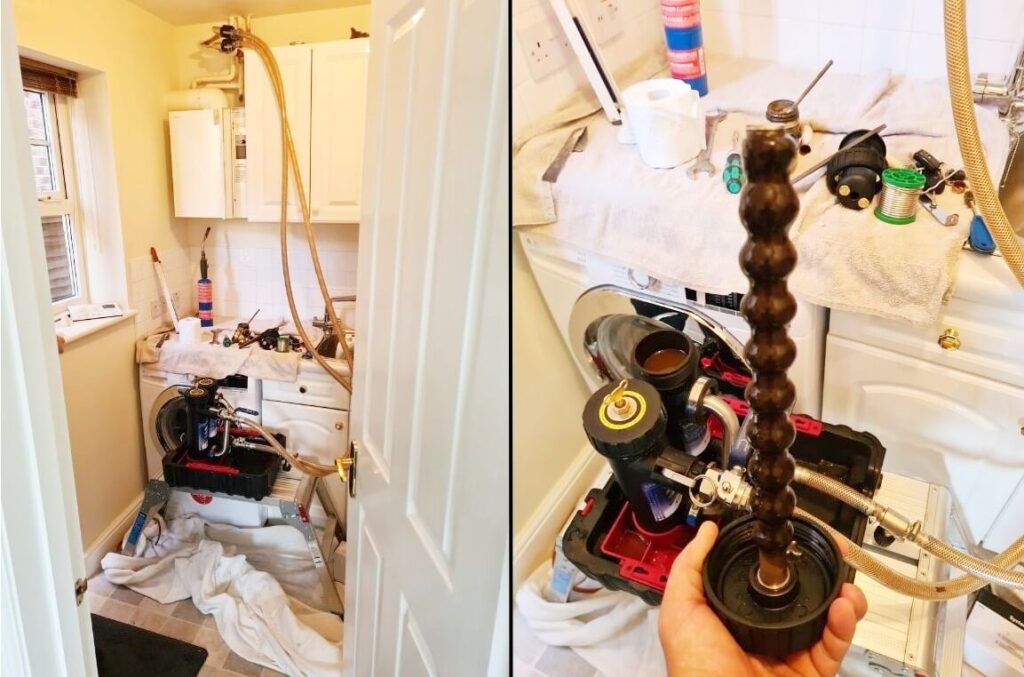
It’s virtually the same process as above, except I will agitate (vibrate) the radiators when the heating is on to get the sludge loosened and moving around.
Some of this sludge and magnetite will be collected on the MagnaCleanse magnets which can be removed with kitchen roll and disposed of.
I agitate the radiators with a cordless SDS drill on hammer-only mode with a special agitating drill bit connected. You can also use a rubber mallet and just keep tapping along the bottom of the radiator.
Power flush
A power flush might be needed if the central heating system is full of thick sludge and causing circulation problems or the boiler isn’t working.
A power flush machine is a powerful pump that can be added to the system to force the thick sludge to move without the need to use the boiler.
You can also use a power flush machine with a Magnacleanse and or a heater to make it even better. The power flush machine pump can be pumped in both directions, helping to reach all the thick sludge stuck in awkward places.
Draining the system
Draining the heating system can be difficult sometimes, like when there is no drain-off valve, or the drain-off valve doesn’t work.

If you don’t have a drain-off valve you should fit one.
On an unpressurised gravity heating system (with no pressure gauge), you must turn the water off at the main stopcock first.
To drain the system you need to:
- Connect a drain-down hose to a drain-off valve and run the hose to a drain outside
- Open the drain-off valve to let the water out
- Wait for the water to stop coming out of the hose
- Vent all the radiators by opening the bleed valves on the highest floor
- Wait for the water to stop coming out of the hose
- Vent the radiators on the next floor down and repeat until every radiator is drained
- Close all the bleed valves
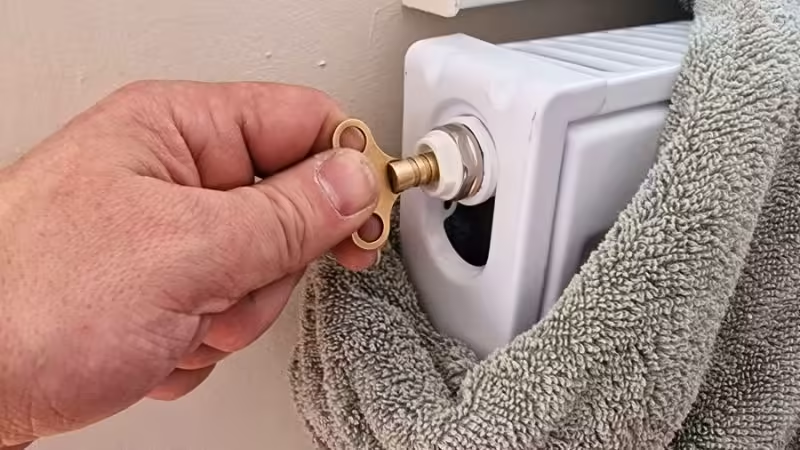
Draining the ground floor radiators can be difficult sometimes if the pipes from each radiator go straight upstairs, like when you have a concrete floor. If this is the case, you should fit a drain-off radiator valve to each radiator on that floor.
Adding cleaner to the system
Adding chemicals to a system is the same process for cleaners, inhibitors, leak sealers or any other heating system chemicals.
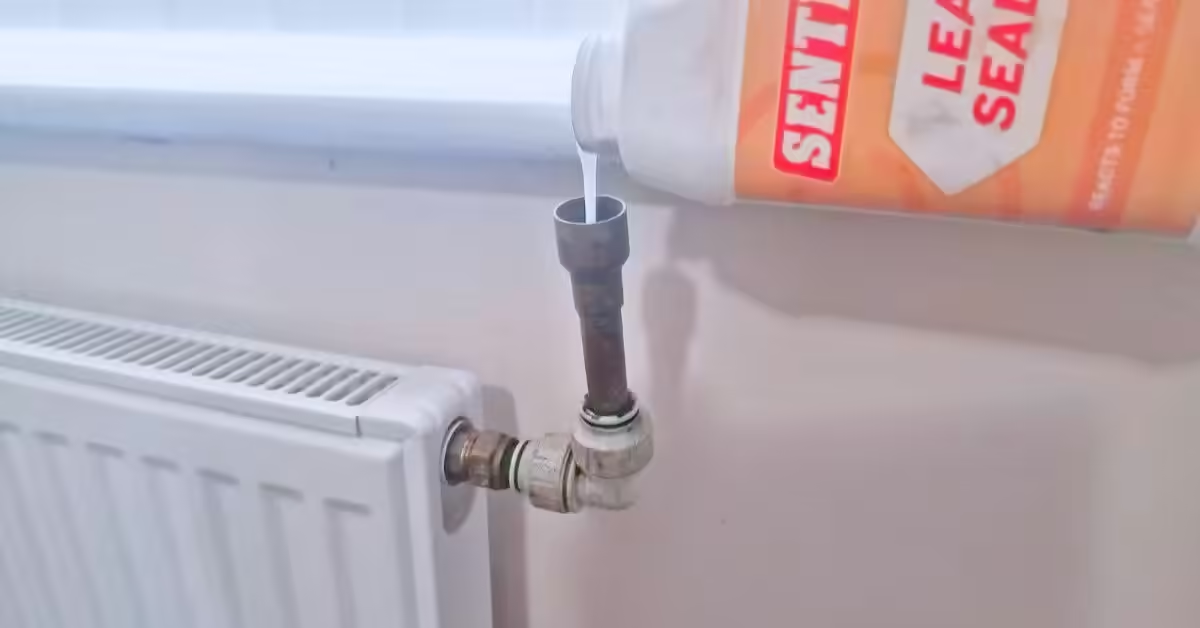
If the system has been drained, it’s a lot easier to add cleaner, but you can add them without draining the system. I always like to get the system hot and drain it fully before adding any cleaner as it can get rid of a lot of the dirty sludge.
Here are 5 ways to add a chemical cleaner to a central heating system:
- Pour into the top of a towel radiator
- Remove a radiator bleed valve and pour it into the hole using a special tool
- Pour into a central heating magnetic filter
- Remove a radiator valve and pour it into the pipe
- Use a pressurised can of cleaner
Towel radiator
The most common (and best) way to add the cleaner to a central heating system is to pour it into the top of a towel radiator if you have one.
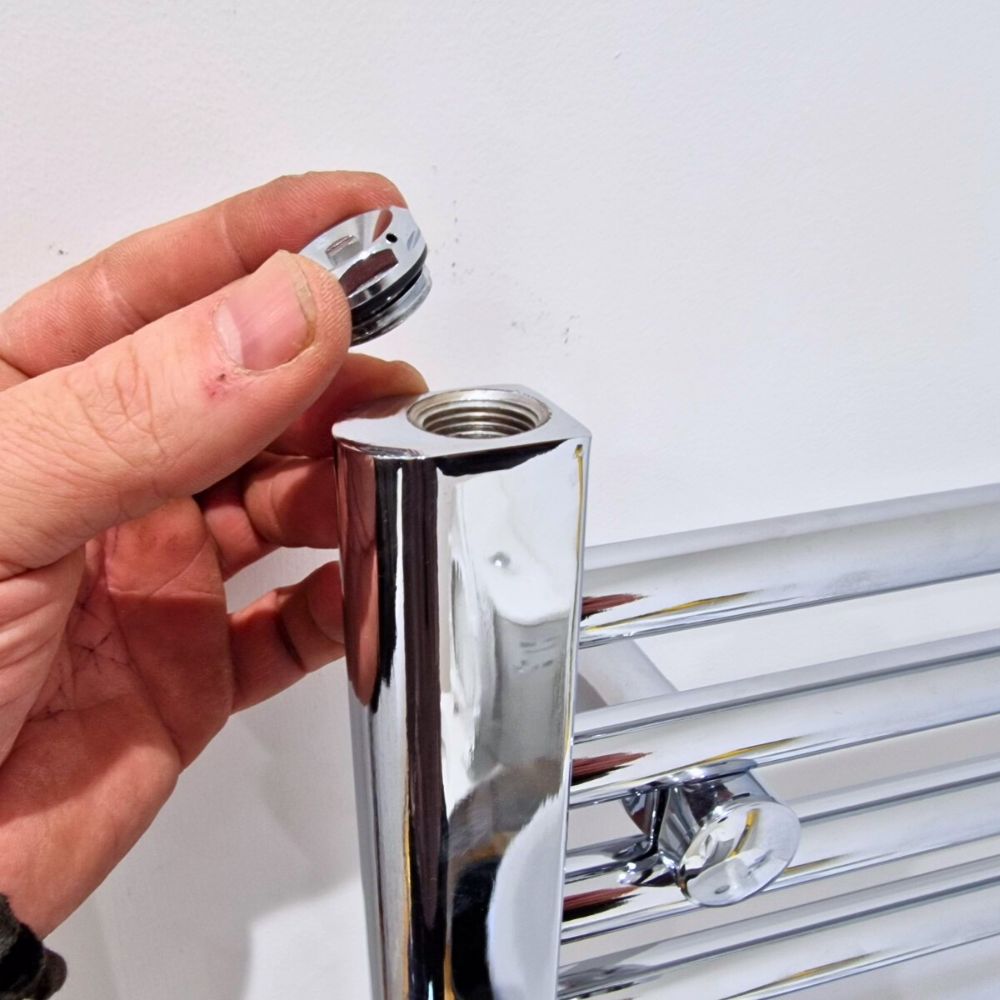
When the system is drained, you can remove a nut from the top of the towel radiator with an adjustable spanner and pour in the cleaner or inhibitor.
Radiator bleed valve
If your radiator has a modern bleed valve with a large nut, you can easily remove the bleed valve nut using an adjustable spanner. Once removed, you can use a radiator dosing tool for any chemical treatment.
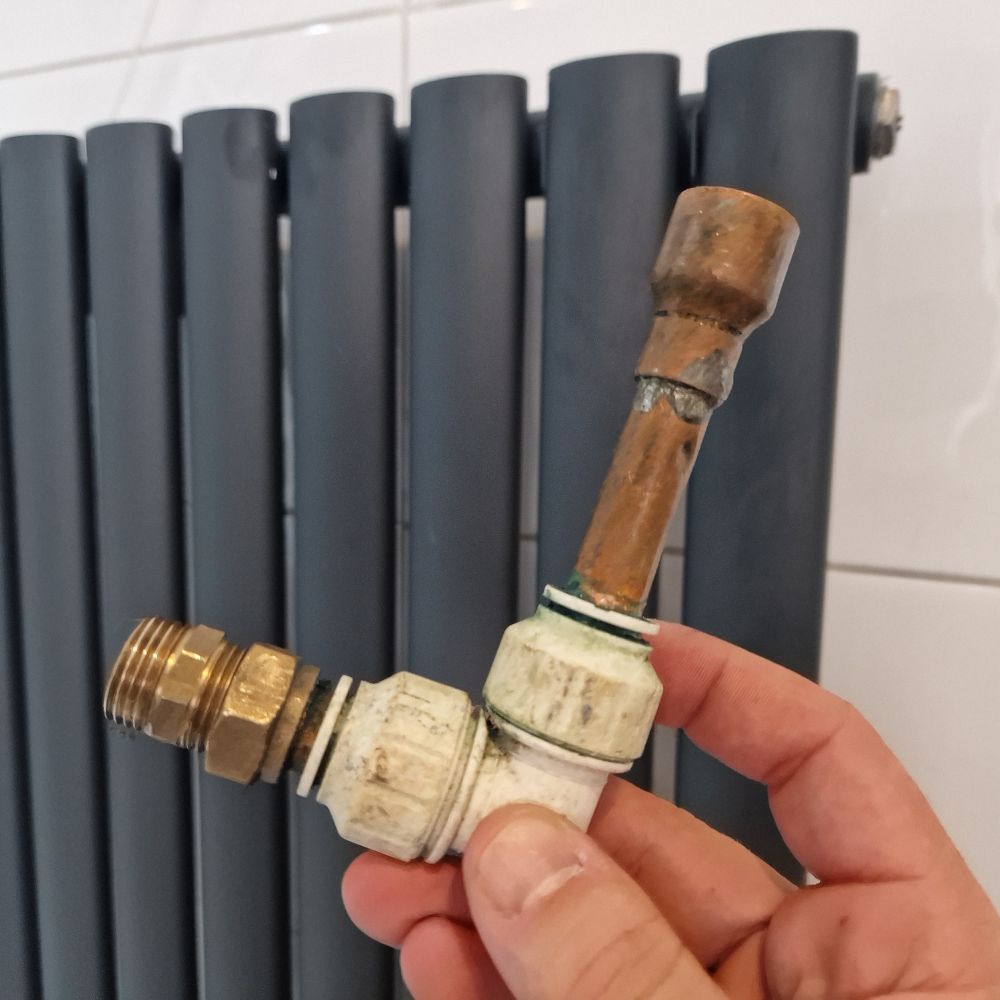
I have made my own dosing tool to keep it as small as possible but you can buy a radiator dosing tool. You need to remove the bleed valve nut and screw the dosing tool into the bleed valve hole before pouring the chemical cleaner or inhibitor in.
Magnetic filter
Adding a cleaner to a magnetic filter is only possible with certain filters.
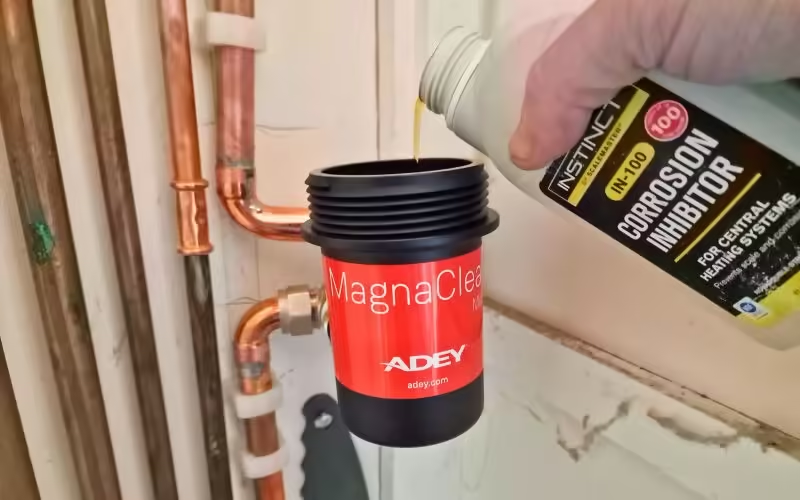
The Magnaclean Professional 2 is one of these filters and is one of the reasons it’s my filter of choice. When the system is drained, you simply remove the top of the filter by unscrewing it, pour in any chemicals, and then refit the top.
Radiator valve
Sometimes you can’t add cleaner to a radiator or magnetic filter, especially if you have old radiators with small bleed valves. If so, you can remove a radiator valve and pour it into the pipe with a small funnel. This can be very difficult, especially if you have small microbore pipes.
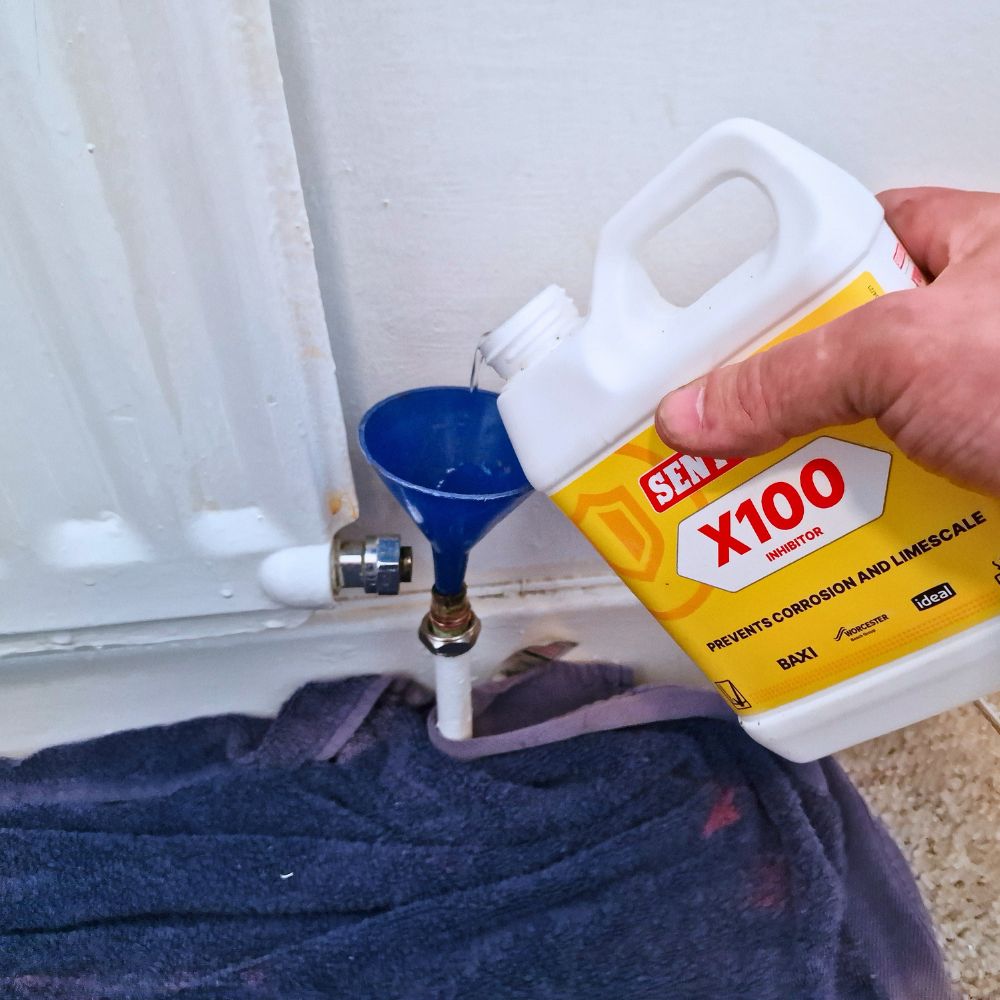
Pressurised can
You can also get pressurised cans of central heating cleaner that can be squirted into the system via the filling loop or radiator. No need to drain the system with these, but it is difficult and they can make a mess sometimes.
Refilling the system
Before refilling the central heating system, make sure all the radiator bleed valves and any drain-off valves are closed.
If it’s a gravity (open-vented) system, turn the water supply back on and wait half an hour for the tank to refill before bleeding the radiators.
On a pressurised system:
- Open the filling loop and repressurise the boiler until the pressure gets to 1.5 bar on the pressure gauge
- Bleed all the radiators starting with the lowest radiators first and working your way up to the highest
- Keep repressuring at the filling loop when the pressure drops

Conclusion
Flushing a central heating system is very hard. The bigger the system the harder it is. After flushing and cleaning the system fully you should always fit a magnetic filter to keep the system clean. This filter can be cleaned out easily and stops the sludge from building up in the boiler and radiators.
Feel free to ask any questions in the comments below, and I’ll do my best to help. If you found this post helpful, please consider sharing it.
FAQs
How often should you flush your central heating system?
You should not need to flush your central heating system regularly. If it is flushed and cleaned properly once and fitted with a magnetic filter, then it shouldn’t need to be flushed again. You can clean the filter as often as you like.
Can I flush my central heating system myself?
Yes, you can flush your central heating system yourself. If you are competent, keen to learn, and have an easy-to-use drain-off valve, then flushing your central heating system is very doable.
How do I know if I have sludge in my radiators?
The best way to know if you have sludge in your radiators is when the radiators are cold at the bottom. The sludge will collect at the bottom of the radiators which is why that part of the radiator will not get hot.


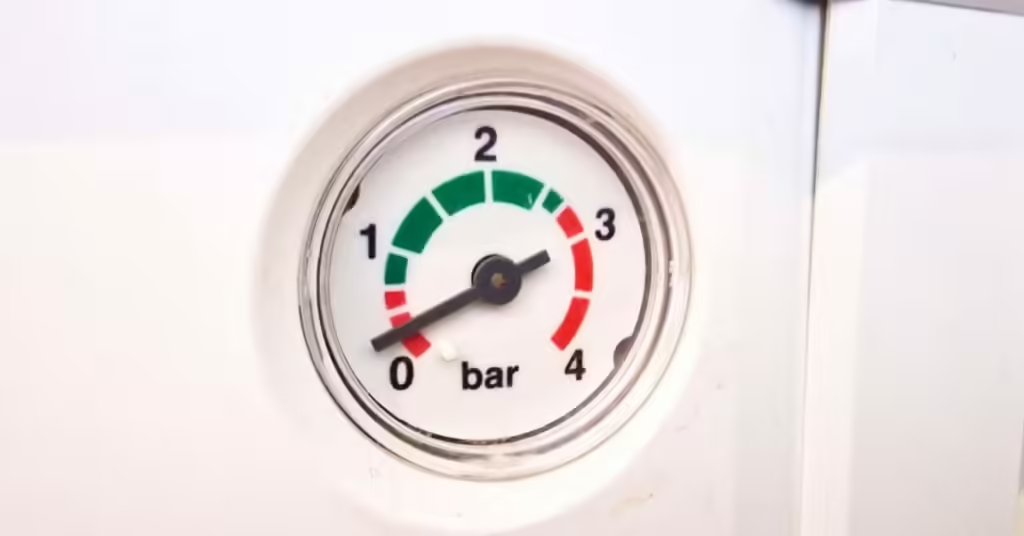

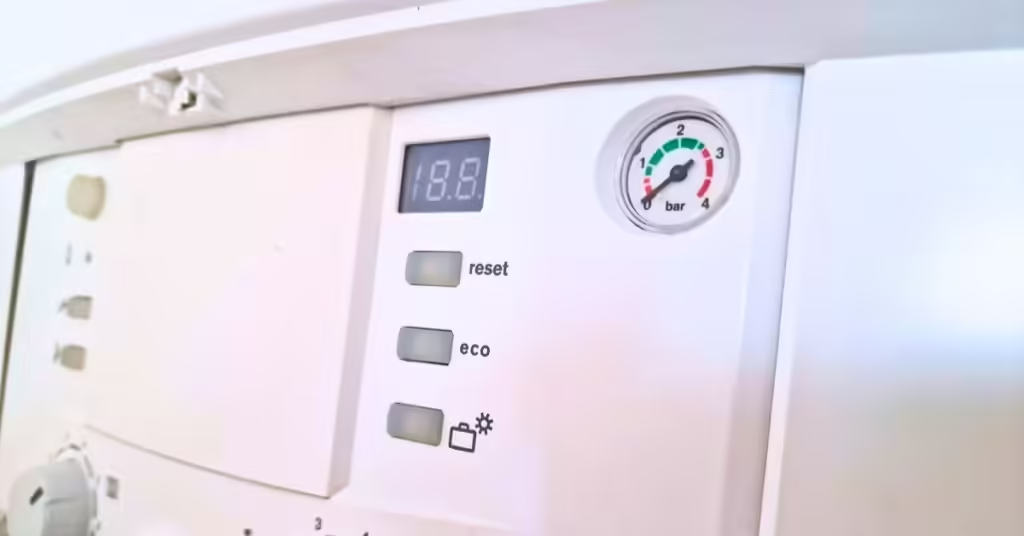
Hi Steven, I have been read through all your articles following a fault in my Vaillant boiler, I am attempting to add Fernox F1 express inhibitor and silencer to the system via filling loop, but hesitate to do so as there are a couple of questions lingering. 1, Do inhibitor and silencer go to drinking/showering side of water system? 2, Is it pressure only for central heating system? If not going to drinking/showering side, why boiler needed pressure to work? Sorry for the naive questions. Looking forward to your educational reply. Many thanks Joseph